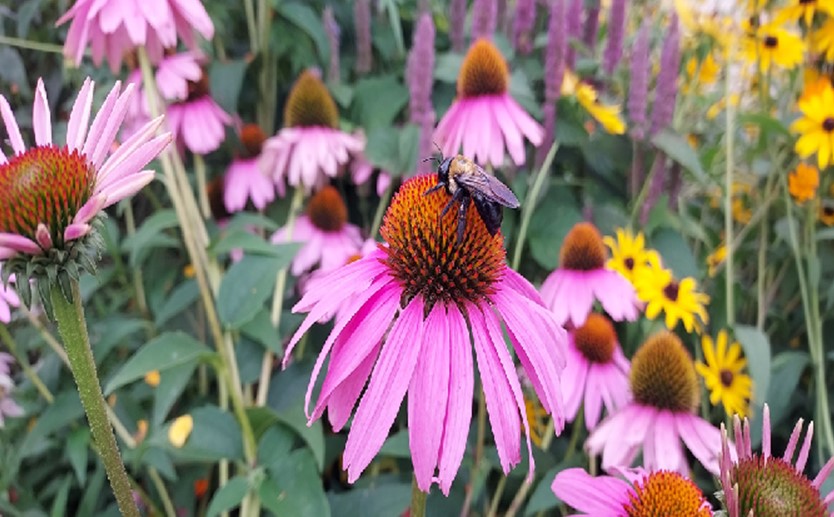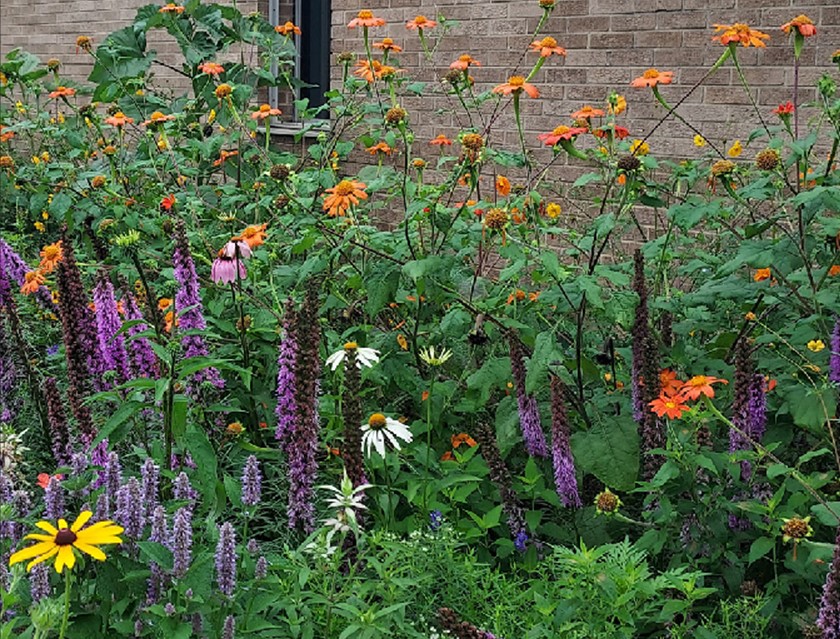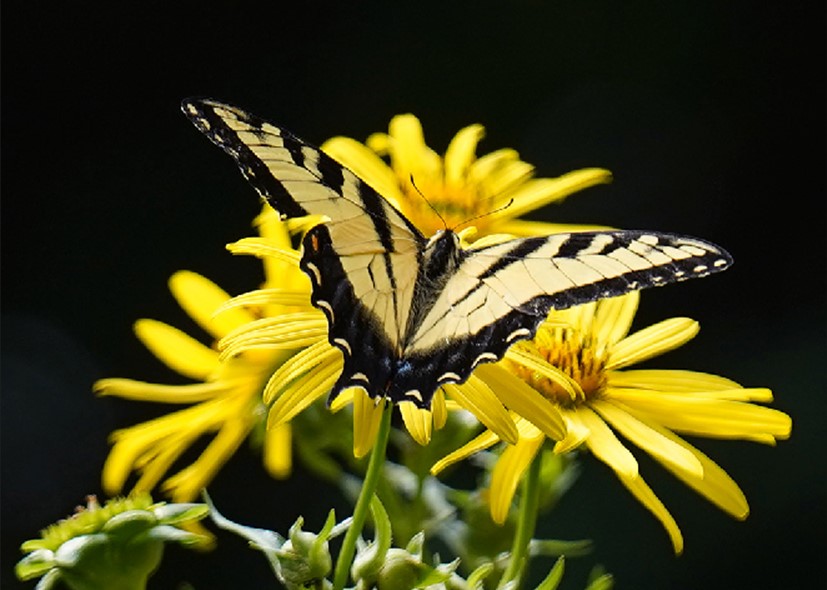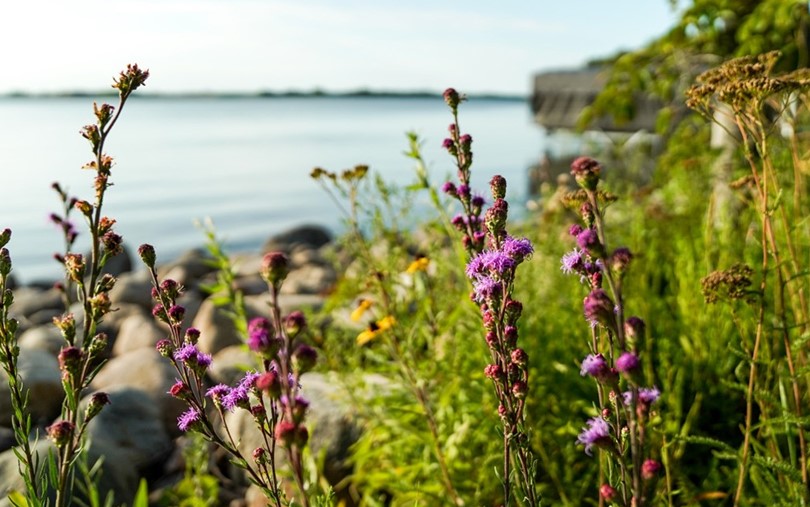
Smart Gardening: Using Native Plants Is a Smart Choice for Michigan Landscapes
DOWNLOADApril 30, 2024 - Barslund Judd & Lindsey Kerr, MSU Extension. Original version (2012) by Joy Landis, MSU Integrated Pest Management Program (retired).
Did you know that you can create a beautiful landscape in your yard with plants that are well adapted to your soil and climate? By carefully selecting plants that are native to Michigan, you can:
- Grow thrifty plants adapted to use available rainfall.
- Rebuild the soil in your garden.
- Filter runoff before it reaches local waterways.
- Create habitat for local wildlife.
- Enjoy a beautiful, resilient landscape.
- Save time, energy, and money.

Getting Smart Around Your Home
Home landscaping and flower garden designs can easily include native grasses and sedges, herbaceous perennials, shrubs, and trees. (Perennials are plants that come back every year.) Native plants offer home gardeners a variety of sizes, flower colors, and bloom times. Native ground covers can be ideal choices if you want to cut back on the amount of turf in your yard.

If you’re not sure where to start with selecting native plants, visit the “Getting Started” page on MSU Extension’s Native Plants and Ecosystem Services site (nativeplants.msu.edu). The “Plant Facts” section of the website includes profiles with pictures and notes from MSU researchers about how attractive the plant is to pollinators and to natural enemies that help control pests.
Then explore the Regional Plant Lists for native plant recommendations specific to Michigan’s southern Lower Peninsula, northern Lower Peninsula, and Upper Peninsula.
Each regional list includes handy tables for:
- Wildflowers
- Ferns
- Trees, shrubs, and vines
- Grasses, sedges, and rushes
The tables cover the native plants’ common and scientific name, flower color, average height, sun needs, and moisture needs.
Before you plant anything in your garden or landscape, MSU Extension recommends that you have the soil in the area you want to plant tested, then repeat the soil test every three years. See the MSU Soil Test page (https://homesoiltest.msu.edu/) for information on how to have your soil tested.
With your soil test results in hand, plant suppliers can help you choose plants that are the best fit for your garden conditions. Many nurseries feature native plants in their inventory. Some plant producers specialize in seeds and plants that are grown in Michigan and are Michigan genotypes.

What Is a Plant Genotype?
Generally speaking, an organism’s genotype is its individual genetic makeup. When gardeners and landscapers use the term plant genotype, they are referring to a highly localized population of plants that are specific to an area and may have genetic characteristics that make them well suited to a particular setting. Local plant genotypes are more likely to survive and thrive than plant genotypes imported from a different region. For example, a red maple (Acer rubrum) seedling from a Florida nursery may grow well if transplanted to a yard in Florida, but may not do well if it is transplanted to a yard in Michigan.
Using Native Plants to Support Wildlife
If you have a soft spot for wildlife—and many of us in Michigan do—choose plants for your landscape that appeal to the insects, birds, and other wildlife you want to help support. Planting native plants in your landscape provides food for the wildlife species that are part of the local food web.
For example, in the spring, many adult birds feed their nestlings insects. By the fall, the young adults will be eating seeds and berries. Leaving seeds and stems standing in your garden over the winter will provide an inviting habitat for birds—not to mention for native bees, pollinators, other insects, and other invertebrates.
Remember that applying any pesticide, including organic products, can harm wildlife populations. Insecticides can kill bees, beneficial insects, and other pollinators. The risk is increased when plants are in bloom.
To learn more about supporting pollinators, visit the Michigan Pollinator Initiative (pollinators.msu.edu) or the MSU Extension Pollinators and Pollination page (www.canr.msu.edu/pollination).

Smart Gardening for Shorelands
According to the Michigan Department of Environment, Great Lakes, and Energy, the state has over 36,000 miles of streams and more than 11,000 lakes and ponds. It’s important to remember that our storm drains, streets, and waterways are all interconnected and that runoff from streets and storm drains can pollute waterways.
Even if you don’t live on or close to a body of water, using native plants can reduce erosion and runoff while providing habitat for birds, amphibians, reptiles, insects, and other wildlife.
For information about suitable plantings near and along bodies of water, visit the MSU Extension Center for Lakes and Streams (https://www.canr.msu.edu/cls).
For more information on a wide variety of Smart Gardening articles, visit www.migarden.msu.edu or call the MSU Extension Lawn & Garden hotline at 888-678-3464.
This work is supported by the Crop Protection and Pest Management Program [grant no 2021-70006-35450] from the USDA National Institute of Food and Agriculture.



 Print
Print Email
Email





